12 Different Types of Screws & Their Uses [Pictured]
Author: Omar Alonso | Editor: Omar Alonso
Review & Research: Jen Worst & Chris Miller
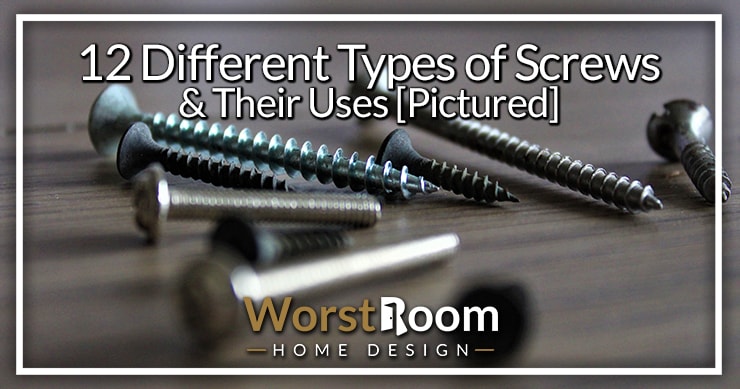
Though it may seem like it isn’t much to look at, various types of screws literally hold things together, from furniture to buildings to hobby projects.
Whether it’s an everyday object such as a wooden bench, cabinet, or putting up your family picture on the wall, there has to be a screw involved.
Though all screws achieve the same purpose, not all screws are made equal. There exists a screw for every specific purpose—there’s a reason that the veritable buffet of screws in your local hardware store is that rich and the aisle so long!
That's why it’s important to know about different screw types so that you can choose the right ones to work with.
Different projects call for different screws. If you’re in the construction or furniture-making business, or are a dedicated hobby enthusiast, or just end up repairing your house very often, you’ll probably know some of these screws already.
12 Types of Screws
Sometimes if you look around online you'll see people talking about 35+ types of screws out there, but then you read and they're describing different types of screw heads and then every tiny sub-type.
In reality, there's only 9 main screw types. The other styles are based on size, material, and screw head and aren't actually main classifications. Let's look at the main ones now.
Wood Screws
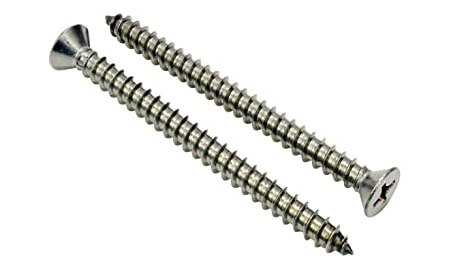
No prizes for guessing what material these screws are meant for! Wood screws are commonly made of bronze, brass, or steel and are used specifically while working with wood.
Their unthreaded shanks at the top and coarse threads at the pointed end make them easy to identify. Just make sure you use the right types of drill bits to create a pilot hole first so you don't crack your boards.
The design also serves as more than just an ID—it allows the screw to smoothly penetrate through wood fibers without causing too much splintering (splintering is reduced by minimizing resistance).
Wood screws can have flat, oval, or round heads. Flatheads are important fasteners for instances when you need screws hidden or sitting flush on the wood surface.
Wood screws differ from metal screws by having threads with wider spacing between them and are typically medium depth, meaning the threads don't always cover the entire screw and will be smooth near the head. Sheet metal screws have tighter threads (more of them) and cover the length of the entire screw.
Oval heads or pan heads are slightly more visible than flatheads, whereas round heads are the most visible and are, therefore, used for decorative purposes. I used all kinds of random wood screws I had saved in a drawer with my makeshift pallet adirondack chair.
Drywall Screws
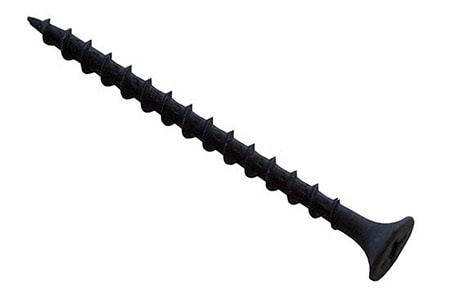
Drywall screws are meant for most types of drywall panels and come in two basic types—coarsely-threaded or W-type screws used to attach drywall to wood, or finely-threaded or S-type screws used to attach metal studs to the drywall.
The latter also comes with a self-drilling tip, so you don’t need to pre-drill. Drywall screws cut through drywalls like a hot knife through butter, thanks to super-sharp tips that reduce tearing while going in fast.
Many different types of drywall screws exist, including those coated with zinc, phosphate, or ceramic and some that are meant to reduce corrosion. They work well with drywall alternatives, too, though you may need to consider some types of drywall anchors in some cases..
Self-Tapping Screws
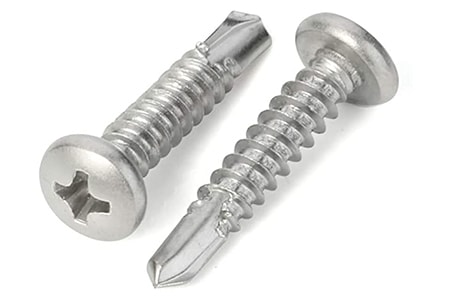
Self-tapping screws are screws that eliminate the need to pre-drill, thanks to threads that facilitate the drilling of the hole while the screw is being inserted. These screws can be drywall, wood, or sheet metal screws.
However, the problem with these screws is that pulling them out results in stripping the screw. They also easily snap when over-tightened.
Sheet Metal Screws
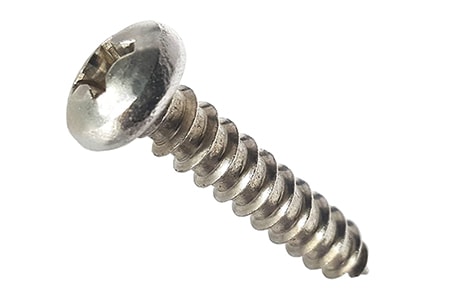
Sheet metal screws can be used in any scenario that requires different materials to be put together, whether it’s rubber, plastic, metal, or any types of plywood.
Therefore, sheet metal screws are available in many types and sizes and the material you’re working with will dictate which screw you use.
Types A, B, and AB are the most commonly found and used sheet metal screws, while Type 25 is rarer and used for specific purposes, generally with plastic. They also come with different heads—hex washer, flat and oval.
Sheet metal screws are extremely efficient thanks to their sharp, customized threads that ensure a tight bond.
Masonry Screws
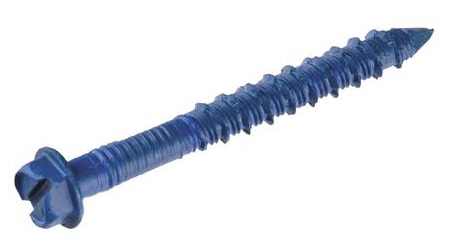
Also called ‘anchors’, masonry screws can be easily told apart from the rest of their family by the lack of a pointed end. Therefore, masonry screws aren’t meant for boring holes and ergo, pre-drilling is required (though any types of drills work, a hammer drill is recommended).
These screws are used to attach concrete to wood or metal, with one of their most common uses being attaching wooden floor plates to the basement floor or concrete types of house foundations.
Masonry screws can have Philips’ heads or raised hex heads that require specific hex-head bits that match (the packaging will tell you which bit and size are required).
MDF Screws
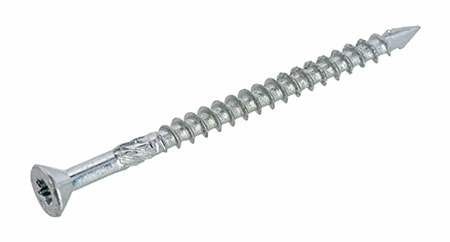
A common appearance in homes in moulding, crown moulding alternatives, and the construction of shelves and bookcases (especially those that require assembly), medium density fiberboard screws are among the most commonly used screws.
These screws are extremely tough screws, since MDF, as a material, is harder than solid wood and quite difficult to pierce. Using wood screws on MDF will, more often than not, result in splitting, unless you pre-drill a hole and then use a normal wood screw.
MDF screws make life easier, especially if you use self-tapping ones. By nature, MDF screws eliminate the need to predrill and the occurrence of splitting. They feature star-drive heads and are available in the same sizes that regular wood screws come in.
Decking Screws
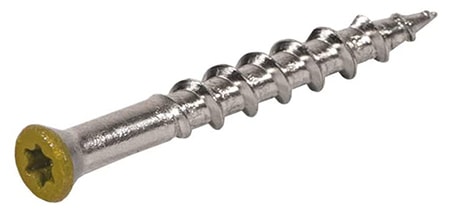
Decking screws are most commonly used to install or fasten exterior decking or deck flooring to a joist system. Therefore, these screws are designed to countersink, meaning that they sit flush or are very slightly below the wooden surface.
Decking screws are similar to wood screws, in that they feature coarse threads and a smooth top shank. They are also designed to resist corrosion and rust—another similarity they share with wood screws.
In case you’re using pressure-treated wood decking, only ACQ-compatible decking screws should be used. In case it’s composite decking, most manufacturers specify the use of stainless steel decking straws for installation.
Decking screws come in various lengths, depending on their purpose and many are self-tapping.
Dowel Screws
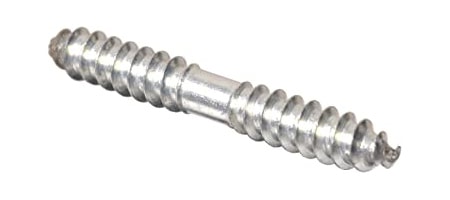
Also called double-ended screws (for obvious reasons) and wood-screw threaded studs, dowel screws don’t feature heads; instead, they feature lag threads on both ends that taper to a blunt midpoint.
These screws are designed for insertion into pre-drilled pilot holes, but their threads also let them be drilled into the wood without any pre-drilling.
Dowel screws are commonly used to fasten or join two pieces of wood. This makes them a common feature in furniture making, finial installation, creating end-to-end joints and other woodwork applications, especially those involving blind holes and single hidden fasteners.
The lack of a head means that a driver tool or locking plier is required for installation.
Mirror Screws
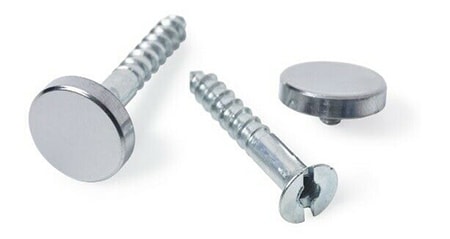
These are specialized screws that help you fasten mirrors to walls sans any additional brackets. Mirror screws feature a slotted countersunk head with a threaded hole; this enables the included cover caps to be screwed on, resulting in easy installation and a stylish finish.
Mirror screws also feature tapered rubber grommets. These prevent the screws from pressing into the mirror directly.
The screws and covers are all coated with zinc, keeping them resistant to rust. This means that these screws can also be used in moist settings, such as bathrooms, without any problem.
Chipboard Screws
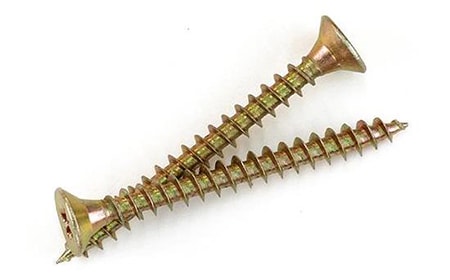
Also known as twinfast screws and particle board screws, chipboard screws, as the name suggests, are self-tapping screws that are meant particularly for chipboard.
The coarse thread, with two times more thread pitch than standard wood screws, makes it easy to drive them into chipboard, particle board and fibre board of different densities.
Due to their ample thread, they can also be easily inserted using ordinary drive bits and hand screwdrivers. The self-centering point on the screw also helps it go in straight and reduce the risk of splitting in the chipboard.
Security Screws
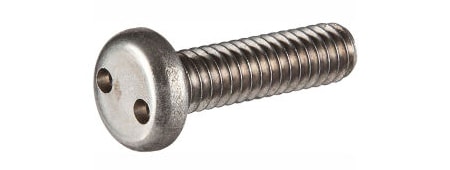
Also known as tamper-proof screws, security screws are more or less standard screws; however, they feature unique heads, which means that common tools cannot possibly remove these screws.
Therefore, any screw that you can’t remove with a Phillips head driver or a slot-style head driver automatically became a security screw.
However, humanity has always found a way around things, which means that security screws are not really so secure anymore, thanks to the innovative minds of those who’ve invented driver bits to get through any screw.
Though the problem may not lie in the security screws themselves, the abundant number of driver bits is definitely a problem.
Hammer-Drive Screws
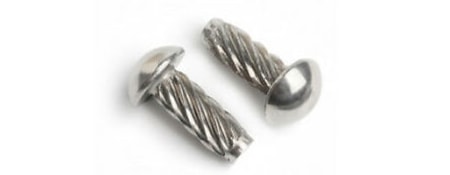
Designed for heavy-duty fastening, hammer-drive screws are also known as U-drive screws, non-slotted round head screws, or simply drive screws. Their rounded heads and unique build ensure that they’re strong, durable and last you in the long run.
Hammer-drive screws are most commonly used to attach signs on the wall, nameplates, or other similar purposes. They also feature multiple start threads and large helical angles, along with a pilot point that’s unthreaded.
You can use standard types of hammers, mallets, or hammer-drive devices to quickly and permanently drive these screws in. You may require an undersized pre-drilled pilot and the screw must be made of a material that’s harder than the part you intend to drive it into.
Types of Screws for Every Use!
Screws exist in abundance, with one screw for every need and purpose. With such specificity in their purposes, it makes it important to know the screw types required, when it’s required, and how best to use it.
Hopefully, this primer on the types of screws sheds some light on this and you now won’t choose the wrong ones for your next hobby/building project.



